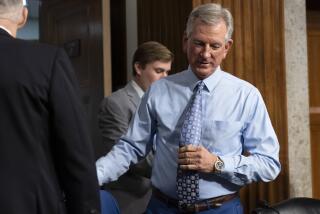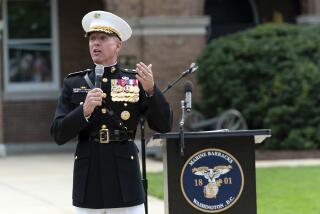A different type of Air Force leader
LANGLEY AIR FORCE BASE, VA. — Defense Secretary Robert M. Gates took action Monday to dramatically reorient the leadership of the Air Force, calling for the nomination of the first non-fighter or bomber pilot to lead the service since its inception after World War II.
His recommendation that Gen. Norton A. Schwartz, who began his military career as a cargo pilot, be nominated by President Bush as Air Force chief of staff marks a significant shift in Air Force leadership.
Over time, the move could lead the service to give more emphasis to missions that support ground wars like those in Iraq and Afghanistan, such as cargo flights and in-air refueling, over more traditional roles like air dogfights.
Schwartz is head of U.S. Transportation Command, which coordinates the Pentagon’s worldwide transportation operations and manages military logistics.
Last week, after receiving a classified report critical of the service’s oversight of the U.S. nuclear arsenal, Gates fired the civilian and military heads of the Air Force.
In recent months, he and other Defense Department officials have been critical of Air Force leadership on a range of issues, including concerns that the service had not done enough to shift its spending priorities to unmanned reconnaissance drones and was lobbying too hard for advanced fighter jets.
In a speech here Monday, Gates said the Air Force’s failure to properly oversee America’s nuclear weapons was the only reason he felt he needed to change the service’s leadership. He admitted to disagreements with Air Force leaders, but said such friction was normal.
Still, there is little doubt that Schwartz’s nomination, expected shortly, will be seen as ushering in a new era. After Gen. T. Michael “Buzz” Moseley was fired as chief of staff last week, many had expected that Gen. John Corley, a fighter pilot and head of Air Combat Command, would replace him.
But senior defense officials said that Gates wanted to make a dramatic move to signal a clear break with the past. One official said Gates was looking for an Air Force chief who did not come with a fighter pilot’s “call sign” nickname.
Officials said that in bypassing the “fighter mafia” for the chief of staff position, Gates is sending a message that the Air Force needs to focus more on Iraq and Afghanistan, where he has struggled to get the service to provide more unmanned reconnaissance drones.
Schwartz does have experience in combat aircraft. He participated in the 1975 evacuation of Saigon and has piloted the heavily armed AC-130 gunships, the workhorse of special forces.
On Monday, Gates cited Schwartz’s long list of assignments in so-called joint commands -- positions where senior officials work in units made up of officers from all four military services. Among other postings, he was deputy commander of the Special Operations Command and director of the Joint Staff, which supports the Joint Chiefs.
Gates said he chose Schwartz because of his intelligence and attention to detail. As the new chief, Schwartz will be charged with improving nuclear oversight, modernizing the aging fleet of tankers and figuring out what kind of fighter planes to build.
“I just felt that Gen. Schwartz brings fresh eyes to these issues,” Gates said in a news conference on a plane en route to Colorado Springs, Colo. “He is very smart, he is very process-oriented.”
But it clearly was not lost on Gates that the appointment would break the fighter and bomber communities’ long lock on Air Force leadership. “This is about the transitioning Air Force,” Gates said.
A retired Air Force general praised Gates’ action, arguing that improving airlift and tanker operations, as well as aerial reconnaissance, should be the service’s top priority.
“To tell you the truth, I think they needed to get away from an Air Force fighter guy,” the retired officer said.
Many officials and former officers interviewed requested anonymity, wary of speaking publicly about the nominations because they were unsure whether Gates intended to make more changes.
In Gates said he was trying to instill a deeper ethic of accountability in all the military services.
The services must be “willing to admit mistakes when they are made,” he said. “That is the only way to fix them -- and it is the only way to ensure that they don’t recur in the future. . . .
“I have noticed that none of the services easily accept honest criticism from outside their branch, or scrutiny that exposes institutional shortcomings,” he said. “This is something I believe must change across the military -- for these critiques are often the most valuable.”
Despite Gates’ comments, both senior and mid-level Air Force officers think that Moseley was ousted, at least in part, because of his aggressive support for purchasing additional F-22 fighter planes.
Some of Gates’ advisors see the plane as expensive and of limited value in fighting unconventional wars like those in Iraq or Afghanistan. But many in the Air Force’s fighter community think it is crucial because of the proliferation of sophisticated anti-aircraft systems in countries such as Iran and China.
The controversy surrounding Moseley’s leadership has divided the Air Force, with some current and former officers lamenting his demise and fretting that his departure could spell the end of the F-22. Its production contract runs out next year.
On the other hand, an increasing number of Air Force officers have begun to argue for sacrificing the F-22, saying the fight has weakened the service in the eyes of the Pentagon’s civilian leadership. To this group, the Joint Strike Fighter, a smaller and cheaper fighter under development, will provide adequate air superiority and allow the dispute to end.
In his remarks Monday, Gates said he was trying to minimize the anxiety the firings had caused. He praised the efforts of airmen in Iraq and Afghanistan, and said that although their role got little attention, it was deeply valued.
“Put simply, without your contributions in the skies, and in many cases on the ground, America’s war effort would grind to a halt,” Gates said.
Gates also said he would end further cuts in the size of the Air Force, which is in the middle of eliminating 40,000 positions. Halting the cuts would leave the Air Force with about 330,000 personnel, down from 356,000 in 2006.
Schwartz’s new role is seen as the key move in a broader shuffle that Gates announced Monday. He also recommended that a veteran Pentagon official, Michael B. Donley, replace Air Force Secretary Michael W. Wynne, who is leaving at the end of the month.
The White House said that Bush intended to nominate Donley and to designate him acting secretary until he is confirmed.
In addition, Gates said he recommended that Bush nominate Lt. Gen. William M. Fraser III as the Air Force’s vice chief of staff and Gen. Duncan J. McNabb, the current vice chief, as Schwartz’s replacement at U.S. Transportation Command.
All of the nominations require Senate confirmation.
The confirmations of Schwartz and Fraser, a veteran of the service’s bomber community, would mean that no officer with a fighter background would be in either of the Air Force’s top two spots.
--
peter.spiegel@latimes.com
Barnes reported from Langley Air Force Base and Spiegel from Washington.
More to Read
Sign up for Essential California
The most important California stories and recommendations in your inbox every morning.
You may occasionally receive promotional content from the Los Angeles Times.











